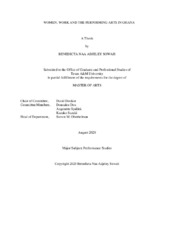| dc.description.abstract | My thesis addresses women and work with a focus on the performing arts. Placing my discussion under W.E.B. DuBois’s theoretical framework of “double consciousness”, I address the attitudes that exist in Ghanaian society about the arts in general and about women in the arts, especially in dance. I explore the dance profession and implications for women who work in that profession in post-independent Ghana. I highlight directions in the area of concert dance and work opportunities for dancers.
The thesis has five Chapters: the introductory chapter (Chapter I) gives a background to the thesis, indicates the objectives, method, and maps out the chapters.
The thesis develops its argument in three chapters after the introduction and ends in a conclusion (Chapter V) with the main points of the thesis.
Chapter II serves as a foundation-laying chapter for Chapters II, III and IV. It explains that Ghanaian women negotiate a strife between their desire, need, and opportunity to work in a constant financially unforgiving economy and, on the other hand, sociocultural expectations that they would also be solely responsible for the care of their homes and children. A context for this strife is gender-related labor transformation: women’s increasing presence in the work force in Ghana and elsewhere in Africa, Middle East, Asia, South America and United States.
Chapter III identifies the strife as something embedded in the tension between a universal humanism that emphasizes common needs, and (oftentimes, patriarchy masquerading as) cultural nationalism—a tension that arises from a core feature of the postcolonial condition in Ghana.
Chapter IV explores the traditional and modern contexts of attitudes about dance/arts, including the “triple burden” that Ghanaian women dancers face. I detail the rise of concert dance in Ghana—which laid the foundation for women to take careers in dance—and show that whereas traditional Ghanaian society valued performing arts/artists, modern Ghanaian society has exhibited degrees of disdain to the artist. I add that this disdain is more intense for working dancers and more so for women. Ending on an uplifting note, I detail growing employment opportunities in dance for women in Ghana. | en |


